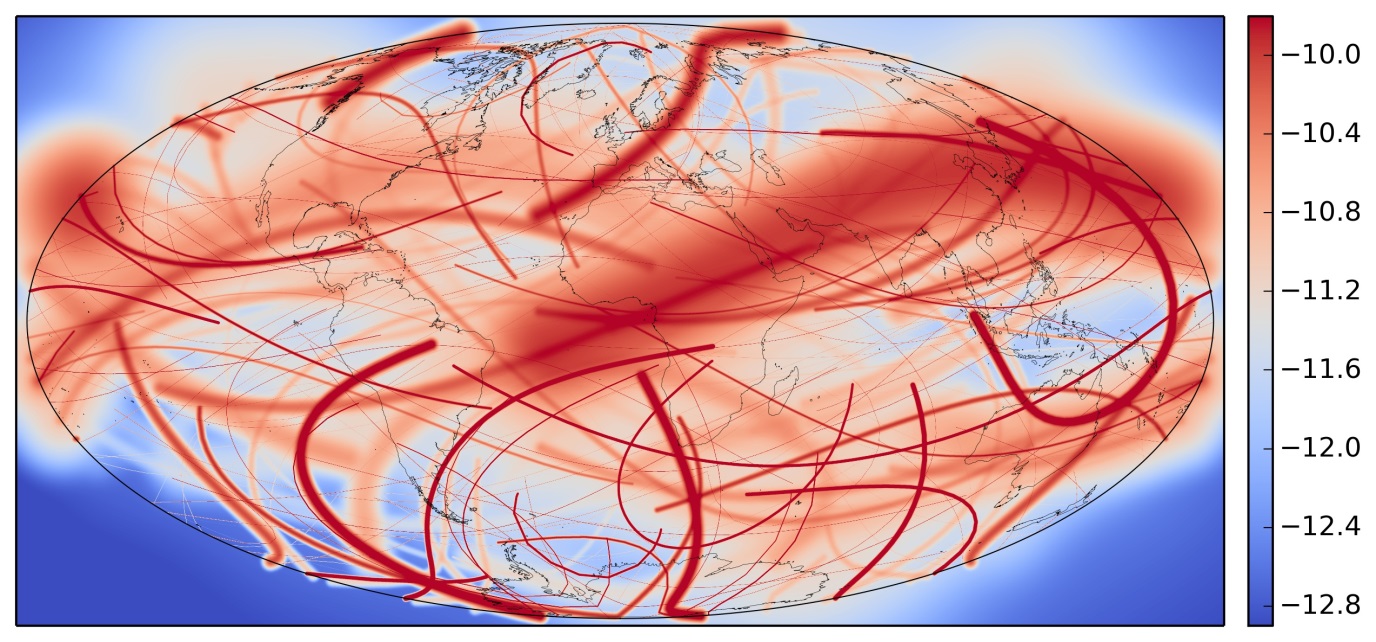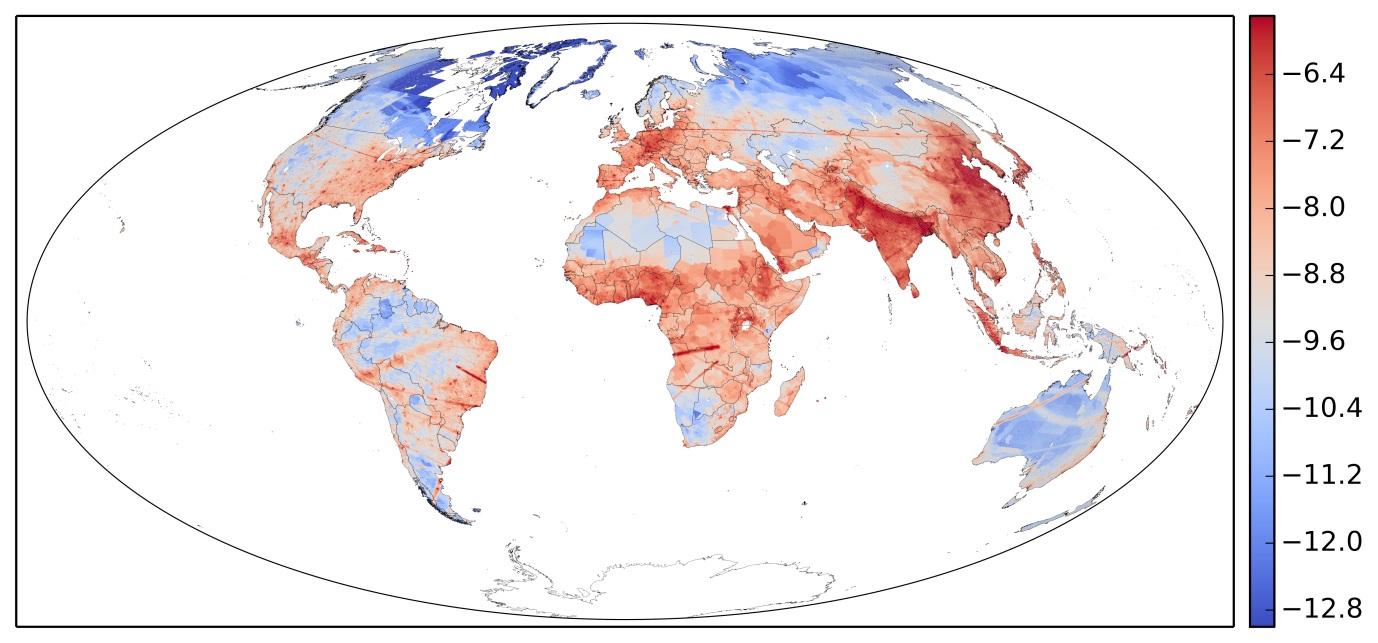1) Research Topic
1.1) Asteroid Risk
My research topic is risk assessment of the asteroid impact threat. Since the beginning of my PhD studies, I have built (and continue to develop) the ARMOR software tool that helps to investigate this subject. ARMOR is able to calculate the potential impact points of asteroids that have been discovered and assign impact probabilities to these locations. Figure 1 visualizes this data on a world map.

Figure 1: Impact location probability distribution (impact corridors) of 261 potential impactors. The data is presented on a logarithmic scale.
Furthermore, ARMOR provides information about impact speed and the angle at which the asteroid enters the atmosphere and this information allows to compute physical impact effects such as shockwaves, thermal radiation, cratering and seismic shocks. In combination with world population data, the modelled impact effects can be used to estimate how many casualties are expected for any given asteroid threat and this risk data is shown on a world map in Figure 2.

Figure 2: Global asteroid risk data. Densely populated areas carry high risk and the impact corridors of certain asteroids are visible. Risk is shown on a logarithmic scale.
1.2) CubeSat Mission UoS3
In parallel to the PhD work, I am co-leading the endeavour to build the first satellite for the University of Southampton. The goal is to experience the whole lifecycle of a space mission and to engage as many students in this adventure as possible. The scientific purpose of UoS3 is to support re-entry prediction of space objects (such as space debris) with experimental data. More information on the project and progress updates are available on the UoS3 webpage (see link below). In addition to its goal of offering as many students as possible (35 to date and more to come) with hands-on experience in building a satellite, the project stands out because of its cross university collaboration of faculties, volunteers and a student society. Notably, the Winchester School of Arts utilizes the project as a source of inspiration for space themed art.
1.3) Outreach Activities
In addition to research activities, I enjoy engaging in outreach activities with the general public. In the past this has led to invitations to speak about the history of spaceflight and how recent developments in the launcher sector are likely to have an impact on everyday life, as well as a guest contribution in the guardian newspaper, and participation in the guardian podcast on the occasion of the International Asteroid Day 2015. In 2014, UK SEDS invited me to talk at their conference to prospective space engineers about my experience as a trainee at ESTEC. Additionally, SpaceNews.com, TheSpaceReview.com and the Dutch space magazine Ruimtevaart have published some of my space policy pieces. Space excites me and I maintain an active Twitter account (@CMRumpf) to comment on space related topics, my research and a bit more.
2) Main Results
ARMOR has been validated against other asteroid entry prediction tools from NASA and against actually observed asteroid impacts and produces plausible results.
Recent research seems to suggest that every region on the Earth has equal chance of being exposed to a future asteroid impact. This situation has commonly been assumed in the field but was never tested in a quantitative way. Furthermore, the equal distribution of asteroid impacts lead to the result that population size of a nation is a suitable proxy for its general risk level associated to the asteroid impact background threat.
In general the results help to better understand the risks involved from asteroid impacts. Notably, the dynamic nature of the risk distribution due to new asteroid discoveries was investigated. The map shown in Figure 2 represents a snapshot in time and the visualized risk situation is likely to change in the future.
3) References
Rumpf C (2015) MONITORING THE GLOBAL ASTEROID IMPACT RISK. International Astronautical Congress 2015 (Jerusalem, Israel).
Rumpf C, Lewis HG, Atkinson PM (2015) GLOBAL IMPACT DISTRIBUTION OF ASTEROIDS AND AFFECTED POPULATION. IAA Planetary Defense Conference Available at: http://eprints.soton.ac.uk/377825/.
Rumpf C (2015) Asteroid strikes are a threat , but space-based telescopes would reduce risk. Guard. Available at: http://www.theguardian.com/science/blog/2015/jun/30/asteroid-strikes-are-a-threat-but-space-based-telescopes-would-reduce-risk.
Rumpf C (2014) Global Asteroid Risk Analysis. International Astronautical Congress 2014 (Toronto, Canada), pp 1–10. Available at: http://arxiv.org/abs/1410.4471.
Burke, J. D., Howells, K., Rumpf, C., & Thangavelu, M. (2015). International Neo Education and Public Outreach. In IAA Planetary Defense Conference. Frascati, Italy.
4) Resources
CubeSat project UoS3 webpage: http://generic.wordpress.soton.ac.uk/uos3/
International Asteroid Day podcast by the guardian: http://www.theguardian.com/science/audio/2015/jun/26/asteroids-threat-life-on-earth-podcast
Twitter Profile: https://twitter.com/CMRumpf